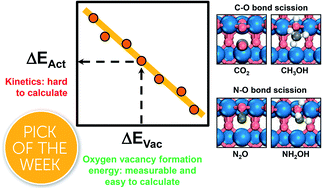Trends in C–O and N–O bond scission on rutile oxides described using oxygen vacancy formation energies†
Abstract
Reactivity trends on transition metals can generally be understood through the d-band model, but no analogous theory exists for transition metal oxides. This limits the generality of analyses in oxide-based catalysis and surface chemistry and has motivated the appearance of numerous descriptors. Here we show that oxygen vacancy formation energy (ΔEVac) is an inexpensive yet accurate and general descriptor for trends in transition-state energies, which are usually difficult to assess. For rutile-type oxides (MO2 with M = 3d metals from Ti to Ni), we show that ΔEVac captures the trends in C–O and N–O bond scission of CO2, CH3OH, N2O, and NH2OH at oxygen vacancies. The proportionality between ΔEVac and transition-state energies is rationalized by analyzing the oxygen–metal bonds, which change from ionic to covalent from TiO2 to NiO2. ΔEVac may be used to design oxide catalysts, in particular those where lattice oxygen and/or oxygen vacancies participate in the catalytic cycles.

- This article is part of the themed collections: 2020 ChemSci Pick of the Week Collection and 2020 Chemical Science HOT Article Collection


 Please wait while we load your content...
Please wait while we load your content...